Cite this document
(“Define the medical model of health and describe the differences when Essay”, n.d.)
Define the medical model of health and describe the differences when Essay. Retrieved from https://studentshare.org/miscellaneous/1571588-define-the-medical-model-of-health-and-describe-the-differences-when-compared-to-the-social-model-of-health
Define the medical model of health and describe the differences when Essay. Retrieved from https://studentshare.org/miscellaneous/1571588-define-the-medical-model-of-health-and-describe-the-differences-when-compared-to-the-social-model-of-health
(Define the Medical Model of Health and Describe the Differences When Essay)
Define the Medical Model of Health and Describe the Differences When Essay. https://studentshare.org/miscellaneous/1571588-define-the-medical-model-of-health-and-describe-the-differences-when-compared-to-the-social-model-of-health.
Define the Medical Model of Health and Describe the Differences When Essay. https://studentshare.org/miscellaneous/1571588-define-the-medical-model-of-health-and-describe-the-differences-when-compared-to-the-social-model-of-health.
“Define the Medical Model of Health and Describe the Differences When Essay”, n.d. https://studentshare.org/miscellaneous/1571588-define-the-medical-model-of-health-and-describe-the-differences-when-compared-to-the-social-model-of-health.


